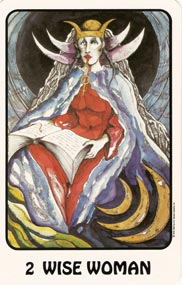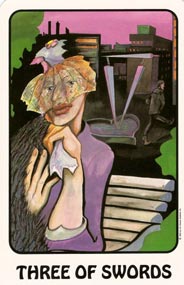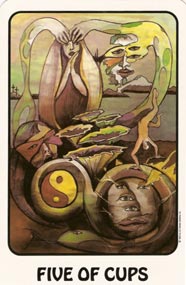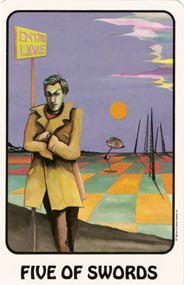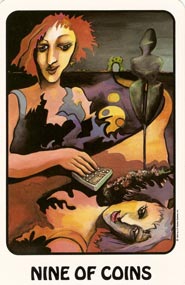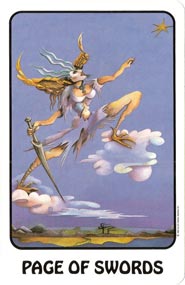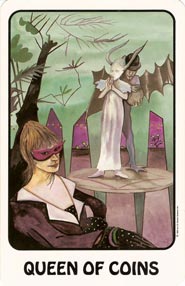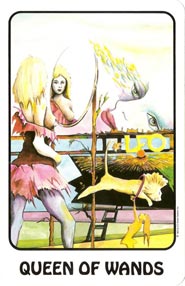Karma Tarot Deck Review
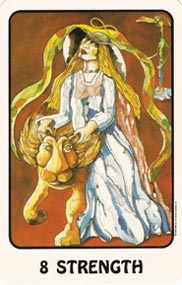
A modern-looking, different tarot published in the eighties. The Karma Tarot cards are based upon artists and musicians the creator knew while living in a commune in Copenhagen.
Deck Type: Tarot Deck Cards: 78
Creators: Birgit Boline Erfurt
Publisher: US Games 1983
Retailers
See Price at Amazon.comSee Price at Amazon.co.uk
Karma Tarot Review by DeLani
The Karma Music Tarot is a surreal, colorful deck unlike any other Tarot I've seen. The cards were done in bright watercolors with a goache technique. The format of the deck is the same as in the traditional Waite-Smith: 22 Major Arcana, and the suits of Coins, Cups, Wands and Swords. The court cards are the traditional Waite-Smith Page, Knight, Queen, and King.
However, the cards are anything but traditional. The scenes are surreal images of artists, dancers, musicians, clowns, and phantasmagoric creatures. The inspiration for these images came from the colorful people living with the artist in Christiana, an anti-establishment area within Copenhagen, Denmark.
To understand the 'atmosphere' of the cards, you should understand Christiana. Erfurt lived in Christiana from 1976-1978, where most of the Major Arcana were sketched by firelight (five cards - Justice, The Hanged Man, Death, Temperance, and The Devil were painted while on a gypsy caravan trip through the Danish countryside).
Christiana itself was a former military compound dating from the early seventeenth century. It was taken over by the youth movement in 1970 and turned into a rustic “free city” where bartering and cooperation were the standard - sort of an urban commune for artists. Heat was provided by wood fireplaces or windmill power. As recently as 1983 (the year of publication), the area continued to feature workshops, music houses and theatres that were open to the public.
This deck is probably not for the novice reader. While some traditional symbolism carries through on the Major Arcana (with some inspiration from the Thoth Deck), the Minors are altogether unique. But if you are brave enough to relax the expectations of the mind, the flowing images can really take you. I don't use this deck often, but when I do, I get very accurate results.
Karma Tarot Review by Spacegoat
Sadly and unjustifiably over-looked, the Karma Tarot has a special place in my heart as the deck which opened my eyes to the limitless sky of possibilities that the tarot can express. One of the first 5 decks I’d bought, back in 1989 at the tender age of 21, this tarot seriously blew me away. I was still finding new twists on the traditional meanings of the cards within its’ phantasmagorical imagery after a year of almost obsessive study and scrutiny.
Hanging around London’s New Age shops (as one does) for the last 20 years, and observing the often perplexed-looking people searching for their dream deck, it became obvious that this extraordinary deck was being given short shrift time and time again. Why? Well, despite the inviting text on the sides of the box, explaining the deck’s inspiration to be the ‘artists, musicians and young people’ within ‘the innovative society of Christiania in Copenhagen’, the image of the Magician on the deck’s box (renamed ‘the Juggler’) seemed to put punters off buying the deck. The image shows a clown with green hair wearing the traditional hat shaped like the infinity sign, coloured with the primaries red, yellow and blue. He appears in a bright green cave, variously brightly coloured mountains behind him. The traditional table with objects of the four suits stands before him. So what is it about this image that seems to put the tarot-lovers off? Well, maybe it’s the gaudy colours, maybe that he’s a clown, maybe that he’s renamed ‘the Juggler’, maybe that his feet are drawn the way children draw feet, pointing outwards. Something about this image puts punters off buying this deck. They miss out. Inside the box, wrapped in cellophane, lives one of the deepest, sensual, elegant and thought-provoking decks there is.
Sure, if you’re used to either simple imagery or realistic, CG detail, the distorted imagery and bright colours may initially be off-putting. At this point, I urge you to take another look.
The creator, Birgit Boline Erfut, acknowledges herself on Strength, being the woman taming the lion (desire), the lion being based on that on the Prince of Wands in Crowley’s famous deck. In the corner of the card a scrawny, bespectacled male appears to be masturbating. He represents the reverse of Strength – submitting to desires, and not being in control of them.
The High Priestess, renamed ‘Wise Woman’, is shocking at first - a woman with a red, vagina-shaped body, wearing a blue cloak. She sits before a black hole, suggesting infinity, darkness and the fathomless depth of the subconscious. The traditional book lies on her lap, but she doesn’t appear to need it, as her eyes turn inward, into herself, into the deep.
The 5 of Cups is a departure from the traditional image, however the image is relevant to the meaning of the card, addressing the process of examining the self after loss or disappointment. Birgit explains in the LWB that the image is based on one of her earlier works, created ‘after a gypsy caravan trip through Europe in 1975, a journey that brought many experiences of clairvoyant magic.’ The Madonna appears in a pod-like form, her hands in an attitude of prayer. To her right is a distorted face with three eyes, suggesting psychic ability. The snake weaves the infinity sign while ‘the dissipated face of the fool...after lighting a fire to his own hair, explodes in burning love to the utmost limits of extrasensory perception’.
The 9 of Coins is fairly consistent with the Waite-Smith image, as Birgit explains: ‘A sinister, yet fertile landscape is the backdrop for a woman in full, established maturity. She enjoys wisdom and success in solitude. The path that leads to her garden is protected by a strange scarecrow that guards her serene security.’
The 3 of Swords is quite a take on the familiar Waite-Smith image. Birgit: ‘A man is leaving a woman to enter the town in the background…the man has defeated materialism and chosen a spiritual path. The sobbing woman, wrapped in her fur coat of materialism, cries out farewell.’ The man who has chosen ‘the spiritual path’ is clearly zipping-up the flies of his trousers (!)
The 5 of Swords is one of the most interesting improvisations on the Waite-Smith image. A stiff, defensive man rests on a sign that says ‘enter freely’. Because of his traditional upbringing he cannot be free. The orange and green squares behind him represent his experience of the passing of time, every day the same…same old, same old….
All the minor arcana’s pip cards are given an ‘Astrological Influence’ (either one or two signs), and a ‘Secondary Influence’ (likewise). These correspondences do not match those observed by the Golden Dawn.
However, within the Court cards the astrological correspondences are very similar to those observed by the Golden Dawn - most noticeably in Crowley’s deck, in which the Knight, Queen and Prince are the mutable, cardinal and fixed signs (in that order) of the element in which they appear. Within the Karma Tarot, this is also observed, but the Page sometimes takes the place of the King for denoting the fixed sign of the suit (in this case, Aquarius on the Page of Swords), and they are generally a little jumbled, but this doesn’t matter, as the Page, Knight, Queen and King within this deck bear images which directly correspond to the Zodiac sign. However, sometimes the ‘odd one out’ is attributed to all 3 signs, as is the case on the Knight of Swords, ruled by Gemini, Libra and Aquarius.
If you love astrology, you will appreciate the care that’s been taken to imaginatively express the signs within the ‘court cards’ of this deck. For example, the Queen of Coins, illustrating Capricorn, shows ‘a melancholy Queen resting after a successful performance…(she) is a melding of two female artists, a painter and an actress, both musicians born under the sign of Capricorn.’ The images shows a scene from ‘the Shepherdess and the Chimney Sweep’. The association with the sign of the Goat is clever – as the LWB goes on the explain: ‘In the Hans Christian Andersen story, the shepherdess and the chimney sweep fall in love. In order for the shepherdess to avoid marriage to a carved, wooden figure, “Field-marshall-major-commander-sergeant Billy Goat’s Legs”, they must leave the home in which they live and go into the dangerous world…the Queen of Coins is like the shepherdess, whose desire for safetly and material beauty conflicts with her need to make sacrifices for what she loves. The horns of the shepherdess and the bat wings and taloned feet of the chimney sweep resemble the Devil on Card 15 of the major arcana.’
The Page of Swords, ruled by Aquarius: ‘A beautiful creature - part woman, part bird – reaches for a star, the symbol of independence, freedom, originality and witchcraft. Her claws rest on the clouds of an electric-blue sky above the county of Thisted, situated in northern Jutland, Denmark. This wind-blown place, where I was born, has been the setting of stories from Nordic mythology to modern fiction……her wavy hair floats freely, denoting unconventional philosophies and powerful intellect. In fairy tales, she cause unexpected events to occur and warns of strange events to come.’ Many of the elements of Aquarius are in this image – freedom, the unexpected, the Star (the Star in the Tarot is ruled by Aquarius).
The Queen of Wands humorously depicts Leo’s ‘look at me’, larger than life persona – the exhibitionist unselfconsciously wearing flimsy garments that reveal one of her breasts. She admires herself in the mirror (Leo’s tendency to be vain). In the background, a lion jumps through a hoop.
I could go on, but it’ll spoil the surprises – the imagery within the court cards in this deck is fascinating, and if you know your astrology, a delight.
The substantial LWB gives detailed text on the images on every card – it’s a joy to read.
I can’t recommend this deck enough. There is so much to enjoy and here. Get a copy soon before it goes out of print - you won’t regret it.
Karma Tarot Review by Lynda Cowles
Some tarot decks speak with startling clarity, instantly shooting their messages with light-speed precision through our eyes and into our brains. Others speak quietly and thoughtfully; they whisper their secrets into our ears while we nod in recognition. And then there are decks which take their meanings, wrap them tightly in symbols, lock them in a puzzle box, and bury them in the middle of the desert. These decks won’t give out their secrets to just anyone – not without a fight.
Despite all appearances to the contrary, the Karma Tarot belongs to this last group. It might seem friendly enough, but ask it a question and it is more likely to dazzle you with a display of acrobatics than give you a straight answer. Reading with it is like waking up from a strange dream. You scratch your head, wondering what Jimi Hendrix and the Mona Lisa were both doing there and why there was a horse climbing out of a man’s skull. You know there’s a meaning in there somewhere but you have no idea what it is.
If it were to end there, the Karma Tarot might make a poor tarot deck indeed. But as with most things, the more you look, the more you realise there is to find and, fortunately there‘s enough that’s appealing about this deck to make you want to delve deeper. The cards were mainly painted in 1976-78, during the time the artist spent at Christiania – a community in Copenhagen where artists, musicians and other innovative young people lived together. This free-spirited, creative environment strongly influenced Erfurt’s art – in fact, many of her friends make appearances in the deck (for example, in the Fool card, which was modelled on a friend who she describes in the LWB as having a ‘child-like and enquiring nature’).
The vibrant, intriguing images come in a strange mix of styles. Some cards tell a single story, while others seem more like collages, depicting a jumble of scenes, people and objects. Most are surreal, featuring a hallucinatory blend of alien landscapes, rock stars, alcohol and circus performers. This, along with the frequent and exuberant nudity (such as in the many-breasted Queen of Cups card), means that this isn’t a deck for minors or those who are easily offended.
Surprisingly, the Major Arcana sticks fairly closely to tradition so there is the Hermit and his lamp and Justice and her scales. Yet this is tarot in the twilight zone, so instead of a chariot we see what appears to be a rocket-powered bathtub, and instead of two towers in the Moon card, there are two wine bottles, emitting an intoxicating and illusory fog. Some of the card titles have been changed - the Empress is Lilith and the Emperor is Osiris, to name but two. Still, the familiar archetypes have not been ignored and this makes the majors fairly easy to relate to. It is in the Minor Arcana where things start to unravel.
What are we to make of the 5 of Cups, for example? The image depicts a brown-green tangle of snakes and eyes and strange funnel-shaped plants. In the background there is a lake, and some mountains and black Christian crosses; in the foreground a masked woman appears to be yawning above a ying-yang symbol. It’s true you could ignore this strange representation and fall back on learned meanings, but that doesn’t help to shake the feeling that you should understand, that somewhere, hidden in one of those eyes, there is something of great significance. The LWB isn’t much help either, despite being a generous 44-pages long. For this card we are told: “When the Madonna wakes us, she imparts a feeling of herself to our minds, and we are thrown back to a capricious choice – dualism unveiled by the ying-yang snakes.” I’m sorry, what???
The problem is that although the images are rich with symbolism, it is the artist’s personal symbolism that is present in many of the cards, which means that the rest of us are left stumbling blindly through the landscapes of her dreams in search of an interpreter. Objects that hold meaning for her, such as strange mannequin figures in the 2 of Coins, which apparently “confirm the decay of love and affection into glassy emptiness”, are potentially meaningless to others. Yet, it is exactly this haphazard symbolism which gives the deck its power. Throw away the little white book, forget what the artist is trying to convey, and make the symbols your own; step into this strange world and describe what you see. Sure enough, things start – slowly – to make some sense, but only if you’re willing to spend some time feeling your way in the dark. Journaling about the cards seems to work; so does meditating, I’m told, though I’ve yet to try that myself.
The quality of the cardstock and printing are both good and the cards have a nice smooth feel to them, but the large-format (13.6 x 8.8cm) can make handling and shuffling – appropriately – a juggling act. The non-reversible backs display the words “Karma Music Tarot Cards” and feature a painted face with a strange contraption emerging from one ear, a reference to Erfurt’s other interest creating experimental music.
Overall, the Karma Tarot is an intriguing deck and one that should not be dismissed without first trying to scratch beneath the surface. It may particularly suit ‘visual’ readers who may be able to look at an image and intuitively get a feel for the mood and what’s going on. Otherwise, it is a deck that can be enjoyed for the phantasmagoric art alone, of which there is more than enough to keep you occupied.
Complete Details of Karma Tarot
Creators: Birgit Boline ErfurtPublisher: US Games 1983
Deck Type: Tarot Deck
Cards: 78
Major Arcana: 22
Minor Arcana: 56
Deck Tradition: Mixed
Minor Arcana Style: Unique Scenes With Suit Symbols
Suits: Cups, Swords, Wands, Coins
Court Cards: Page, Knight, Queen, King
The Fool is 0
Strength is 8
Justice is 11
Card Size: 3.50 x 5.37 in. = 8.89cm x 13.65cm
Card Language: English
Card Back: Unknown
Rating: 12/20 or
Similar Decks to Karma Tarot
Category: Available Tarot Decks, Cartoon Tarot Decks, Tarot Decks from the 1980s< Previous Deck · Back to Top · Next Deck >
Home > Tarot Reviews > Karma Tarot Review

